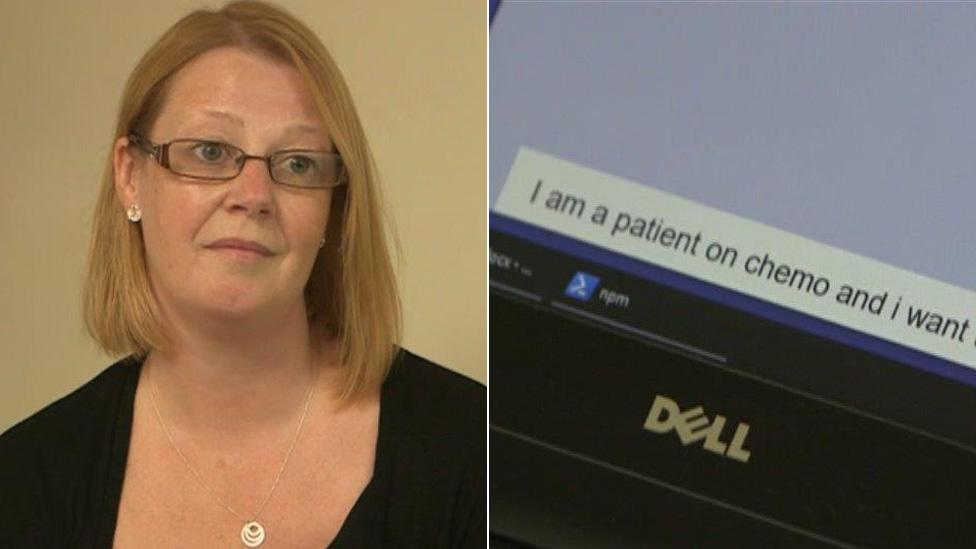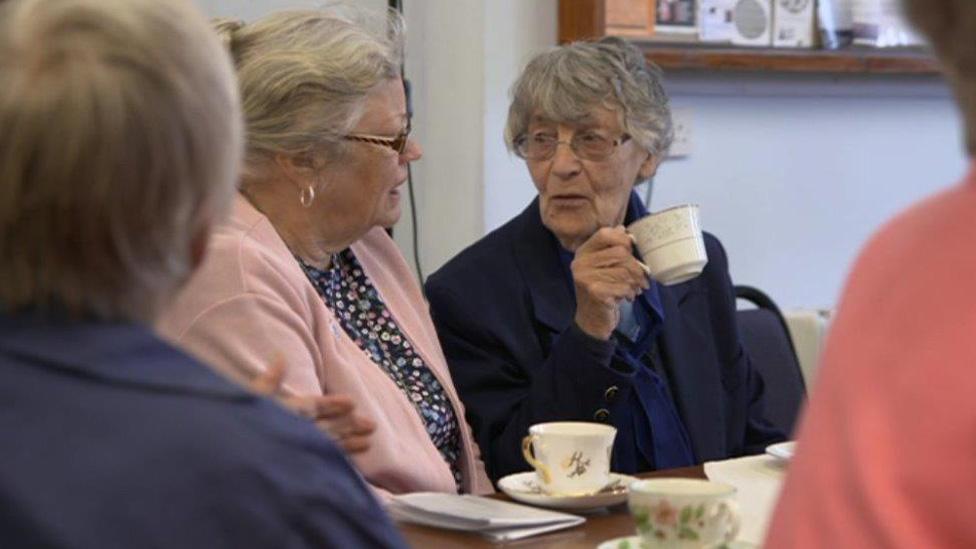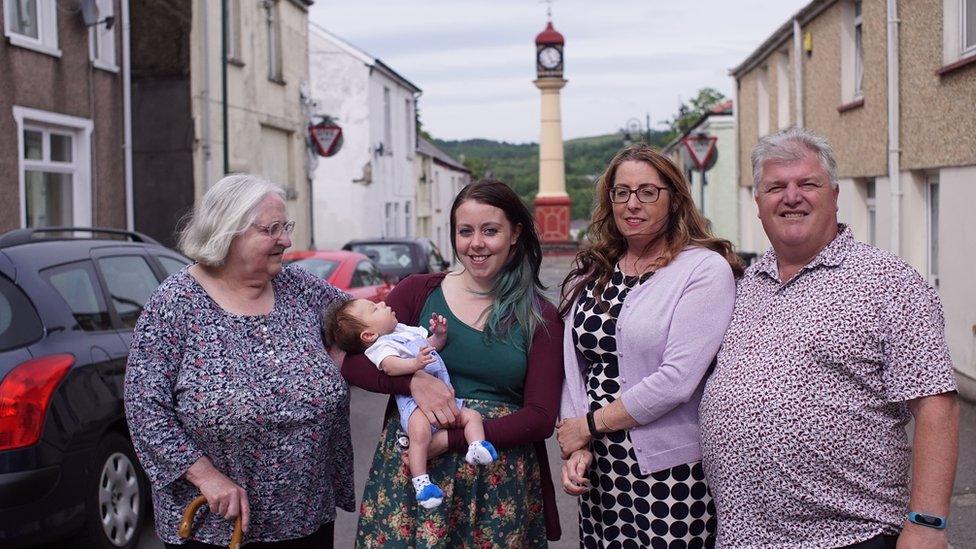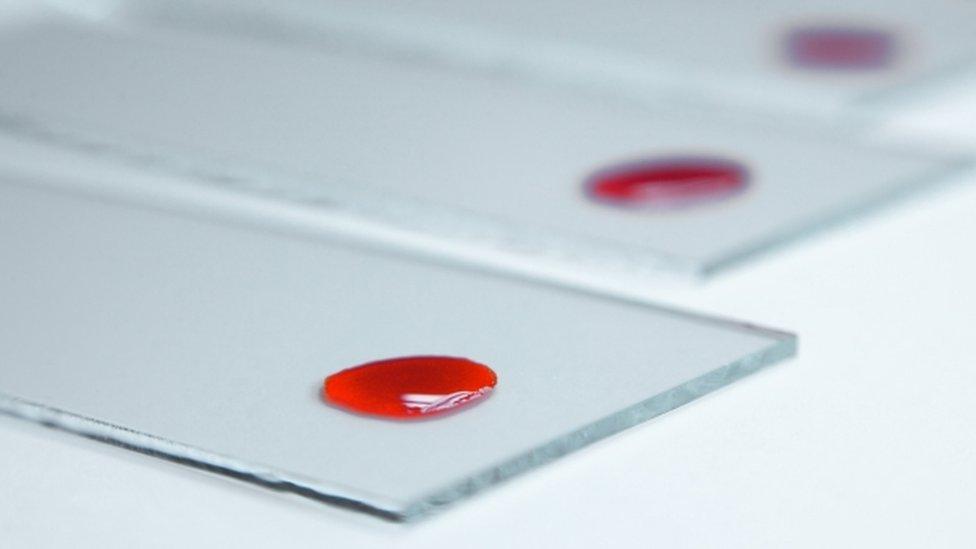NHS 70: Technology could transform health service by 2048
- Published
Cari, 11, imagines a health service with 'a lot of robots'
What could the NHS look like in Wales by the time of its 100th birthday?
Cari, 11, from Llanrwst, Conwy, a fan of the CBBC series Operation Ouch!, imagines there will be more robots.
Not just helping surgeons but possibly assisting at reception at doctors' surgeries.
She won a competition which asked primary school children to depict what they think the NHS in Wales will look like in 2048.
Although her idea of a robot doctor might be for the moment science fiction, the use of robotics in operations is already happening.
Artificial intelligence (AI), wearable technology and apps which can help monitor and detect potential problems are also set to transform how the health service looks.
We asked nine different branches of the NHS in Wales and all were prepared for innovations which could transform how things could look in 30 years time.

Debbie Murphy is testing an app to answer cancer patients' questions 24 hours a day
At Velindre Hospital in Cardiff, virtual reality goggles are already helping cancer patients experience what it is like to lie in a radiotherapy machine.
And an app - using an AI system - is being developed to answer questions and give reliable advice to patients at any time of the day or night.
Debbie Murphy, who has had breast cancer in 2014, is helping to test it out and hopes it will give patients more control.
"Most of the questions came in the middle of the night when everyone was sleeping and I was wide awake and had hundreds of questions that needed answering, I'd go to Google and get frustrated and needed somewhere to go to," she says.
"From when you're first diagnosed until your first consultation, it's an agonising wait and you don't know who to contact. Support is a huge thing."

In miniature: The NHS 2048

Nanomedicine in working with particles with a diameter more than 3,000 times smaller than the width of a human hair
Prof Steve Conlan, director for Swansea University's Centre for Nanohealth and head of enterprise and innovation at the Institute of Life Science, is tackling endometrial, breast and ovarian cancer diagnosis and treatment at a microscopic level.
A human hair is 80,000 nanometres (nm) in diameter - but this is dealing with particles of 25nm.
"The future of more effective healthcare lies in better diagnosis and treatment, and this is where nanomedicine, the application of nanotechnology in medicine comes into play," says Prof Conlan.
"Nanomedicines are medicines that have been engineered into special delivery packages called nanoparticles. By doing this, a chemotherapy that is usually injected into a patient and can have toxic effects all over the body is instead targeted only to cancer tumours delivering the chemotherapy drug just where it is needed, more safely and more effectively.

Prof Steve Conlan said nanomedicine could 'revolutionise cancer care'
"Nanodiagnostics are based on the miniaturised electronics technology used in everyday life, like in mobile phones. By adding special proteins to the surface of the electronics, markers of a disease that are present at very low levels in blood, urine or even saliva can be detected, allowing disease to be diagnosed or how the body is responding to a treatment to be checked.
"But rather than having to go to hospital for these tests, because they are miniaturised (nano), this can be done in the GP surgery, pharmacy or even at home. And the technology will send the result directly to your doctor, so they can see the results.
"These innovations could revolutionise cancer care; nanosensors will allow cancers to be detected earlier, before they spread through the body (metastisis), allowing tumours to be completely removed by surgery. And where this is not possible, nanomedicines aim to deliver more effective treatments, with the ultimate aim of curing cancers."
Virus trained to destroy ovarian cancer

But as well as technology, expect advances in genomic medicine and a new wave of personalised, treatments tailored to our genetic make-up.
Tiny mistakes in DNA which cause disease could be corrected.
And preventative measures or tests could be targeted at a certain period of our lives - if our genes suggest we could be susceptible to ill health at a certain age.
Health economist Prof Ceri Phillips said new technology and revolutionary genetic treatments could put the NHS on firmer ground.
But he said far more emphasis was needed on care in communities or he fears the NHS could struggle.
And with people living longer and in our communities, there will need to be more of a reliance on families, neighbours and voluntary sector offering support or keeping an old fashioned eye out.
"Around the patient we need a professional network but we also will need an informal network - to enable the professionals to operate effectively and efficiently," says Prof Phillips.

Volunteers bring elderly and isolated people together in Solva in Pembrokeshire
Solva Care started in Pembrokeshire three years ago. Volunteers pick up prescriptions or shopping and hold coffee mornings, music and movement and a monthly cinema to bring people together who might be otherwise be isolated.
Coordinator Lena Dixon said: "If people are less lonely they're less likely to go to see a GP just to see a friendly face. And we have 30 people happy to give hours of their time every week."
Health Secretary Vaughan Gething said the next 30 years would be about transforming health and social care but there needed to be "greater pace and scale" in delivering best practice.
"If we're able to do that, we can be positive".
- Published26 June 2018

- Published2 July 2018

- Published4 July 2018

- Published4 October 2017
